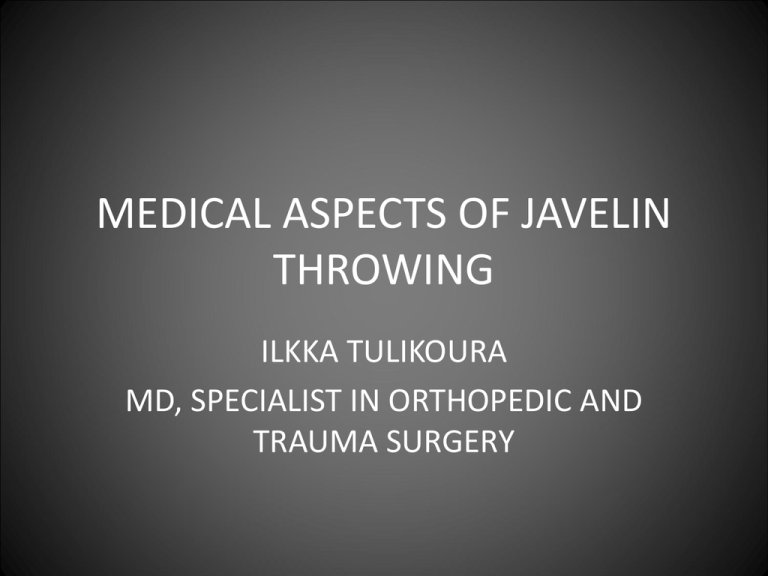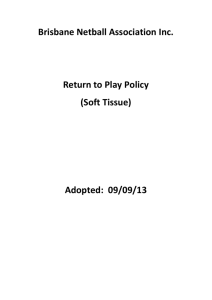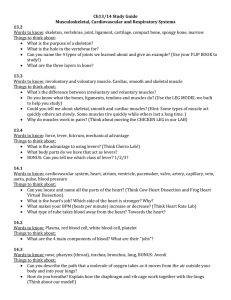MEDICAL ASPECTS OF JAVELIN THROWING
advertisement

MEDICAL ASPECTS OF JAVELIN THROWING ILKKA TULIKOURA MD, SPECIALIST IN ORTHOPEDIC AND TRAUMA SURGERY JAVELIN THROWING RUNNING CROSS-STEPS THROWING VERY RAPID MOVEMENT CHAIN OF BODY AND EXTREMITIES SUPPORTING LEG • High axial loading: HIP, knee, ankle • Thigh muscles can operate as shock absorber • Going over instead of total stop decreases stress • Foot stright ahead is important POSSIBLE INJURIES OF SUPPORTING LEG • Bone stress injuries in joint areas • Local bone necrosis in joint areas • Bone fractures rare • Joint distorsions if foot not stright ahead • Osteoarthrosis (hip) in older age BACK LEG • First rapid and large abduction of hip • Strong and rapid rotation of hip to hyperextension • Thigh muscles important in shock absorption – exentric work POSSIBLE INJURIES OF BACK LEG • Distorsion of hip: labrum injuries, ligament injuries rare • Stretch/avulsion injuries of thigh muscles (adductors) • Distorsion injuries of knee and ankle • Osteoarthrosis in older age BODY AND BACK • Body strongly bent sidewards and backwards • Body rotation varies • With the body rotation load in back part of spine increases • Spine supporting muscles important to protect the back part of spine BODY AND BACK • First body is bent sidewards • With rapid rotation bending turns backwards • It causes heavy stress to back part of spine and tension stress for abdominal muscles • Evenly distributed rotation and bending of spine is important • Supporting muscles are important POSSIBLE INJURIES OF SPINE • Stress injury of bone in the back part of spine • Fracture of the back part of spine • Spondylosis of spine (degenerative changes) in older ages spondylosis EXTENSION OF BODY AND BACK • Important part of throwing • Body is coming back close to neutral position • Body muscles regulate movement • Injury risk is quite small THROWING ARM • First arm maximally rotated outwards in shoulder • Repeating this rotation, structures in front of joint are stretched • ROM increases • Impingement causing pain develops back part of joint THROWING ARM • Path of hand varies during stroke phase • Path of hand close to head seems to be better • Effector muscles need support of efficient front structures STOPPING OF THROWING ARM Infraspinatus Teres minor and major Latissimus dorsi Back part of deltoideus Hand velocity Up to 100 km/h POSSIBLE INJURIES OF SHOULDER • Instability of joint forwards • Luxation rare • Internal impingement in back site of joint • Stretching injuries of outwards rotator tendons - painful • Injury and scarring of back joint capsel – limited ROM and pain ELBOW OF THROWING ARM • Stroke close to head • Movement in elbow more physiological (hinge joint) • Stress in elbow less • Risk of injury less ELBOW OF THROWING ARM • Stroke far from head • Forearm twists into valgus • High stress on inner site of elbow • Olecranon bone hits against inner edge of olecranon fossa: impingement POSSIBLE INJURIES OF ELBOW • Ligament strain on inner site of joint • Ligament rupture on inner site: instability • Painful impingement in back of elbow: osteophytes and limited extension • Osteoarthrosis in older ages HOW TO PREVENT PAINFUL PROBLEMS AND INJURIES? IS IT POSSIBLE? TWO DIFFERENT TARGET BUT SAME DOING! OPTIMAL MOVEMENT CHAIN IN JAVELIN THROWING BRINGS BEST RESULT: LONGEST THROW OPTIMAL MOVEMENT CHAIN IN JAVELIN THROWING MINIMIZES RISK OF INJURIES HOW TO GET OPTIMAL MOVEMENT CHAIN? WHICH IS OPTIMAL MOVEMENT CHAIN IN JAVELIN THROW? • On the base of video about longest throws we can evaluate approximately optimal movement chain • On the base of video about bad throws we can evaluate which probably does not belong to optimal movement chain MUSCLE GENERATES KINEMATIC ENERGY IT IS USED FOR: • Accelerating movements • Balancing action of effectors • Attenuating movements of body and hits of foreign objects CONTROL OF JAVELIN THROW • Rapid javelin throw is controlled automatically by brain • Restoring automatic control program needs plenty of repetitions • Repetition of bad throws stores bad automatic program in brain: optimal movement chain is difficult to carry out PAIN AND THROWING CONTROL • Painful state disturbs throw control: performance is bad • It is better to avoid throwing with pain for preventing bad automatic control program storing • Painful throwing inhibites healing of injury and involves risk of new injury VICIOUS CIRCLE DECRESED CONTROL INCREASED PAIN WEAKENED MUSCLES DECREASED MUSCLE TRAINING COOPERATION OF SHOULDER MUSCLES • Optimal movement chain is result of over 20 muscles cooperation • Correct muscle balance between all muscles is needed to avoid bad throws • Muscles cannot be tired • No muscle can be weak MUSCLE BALANCE – WEIGHT TRAINING • Majority of power training is one-sided • Target is to increase power of effector muscles • Result is muscle imbalance MUSCLE IMBALANCE AND THROWING • Throwing with lesser power, optimal movement chain is possible • With higher power, weak muscle does not clear: optimal movement chain is lost • result is bad and injury risk is high HOW TO GET RIGHT MUSCLE BALANCE • Power training diverse • However power performance spesific to javelin throwing is needed • Shot throwing, for instance, is spesific • But, shot throwing does not grow stopping force MUSCLE GENERATES KINEMATIC ENERGY IT IS USED FOR: • Accelerating movements • Balancing action of effector • Attenuating movements of body and hits of foreign objects IN JAVELING THROWING • Target is high velocity of javelin • First movements are accelerated • At the end of throw, velocity is attenuated and movement is stopped SHOCK ABSORBERS • Stop rotation of body • Stop whole movement of thrower – supporting leg • Stop swing of upper extremity ATTENUATING WORK OF MUSCLE • Muscle is contracting and stretching during same time • It is called exentric muscle contraction • This is fine cooperation between muscles and nervous system • Optimal attenuating function needs exentric training • Optimal attenuating function needs strong enough muscles IF ATTENUATION OF MOVEMENT FAILS • Movement is going on • Kinematic energy affects supporting strctures of body Results are: • Painful states in supportive tissues • Stress injuries in supportive tissues • Ruptures and fractures in supportive tissues WHY ATTENUATION WORK FAILS? • Training focuses too much to effector muscles – common error • Shock absorber muscles are to weak • Shock absorber muscles are tired • Attenuating function is trained to little: both exentric and consentric training are needed • Painful state in shock absorber inhibites power increase of attenuating muscles VICIOUS CIRCLE DECRESED ATTENUATION WEAKENED MUSCLES INCREASED PAIN DECREASED MUSCLE TRAINING SIGNIFICANCE OF RESULTED INJURIES • Some injuries can be treated non-operatively • Some injuries need operative treatment • Some injuries can not be treated effectively enough to continue competing javeling throwing • Some injuries cause permanent trouble • Some injuries cause troubles in older age BODY ROTATION TRAINING CONSENTRIC EXENTRIC LEG EXENTRIC TRAINING ADDUCTORS GROIN AND ABDOMEN SUPPORTING LEG TRAINING ARM STOPPER TRAINING consentric ARM STOPPER TRAINING exentric Braking with one arm EVEN BENDING OF SPINE TANKS A LOT ! JAVELIN THROWING, HOWEVER, HAS A PRICE







